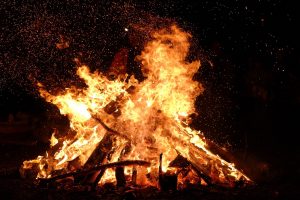Halloween is famously an evening of tricks or treats, spooky costumes, and carved pumpkins (also neeps in some parts of Scotland), but the event has a rich history and cultural heritage which can be related back to the Gaelic festival of Samhain; an event marking the end of the harvest, and the beginning of winter.
Samhain is considered a time when the doors to the otherworld open, and supernatural souls of the dead come into our world. Because of the liminal nature of the boundary between the world of the dead and the living, it was not uncommon to welcome the dead into one’s home: setting places at a dinner table for when they revisited. This, of course, should be expected at a time of year when nature appears to die, trees losing their leaves and fields becoming bare. After all, where else is there for the spirits to go other than inside, to the warmth of cottages?
It is believed that Samhain later transitioned into the Halloween that is commemorated globally today. This is most likely thanks to a Christianization of the festival. Halloween takes place before the Christian holy day of ‘All Hallow’s Day’, also known as ‘All Saint’s’ or ‘Hallowmas’ on the 1st of November. On this day Christians honour all saints known and unknown. This is because of a belief in a powerful spiritual bond between those in heaven and those living on earth. It’s worth noting that ‘All Saint’s Day’ was commemorated on another day in the calendar year before being transitioned to the 1st of November in 835 A.D. This leads some to speculate that the Christian tradition may in fact predate the celebration of Samhain.
The way in which Halloween is commonly celebrated today has its roots in the traditions of Samhain. For instance, it is believed that the Halloween costume derive from traditions of mumming or guising in Scotland, Ireland, and Wales. It was recorded in the 16th Century that people would go from house to house in costume or disguise, and recite songs for food. Naturally the idea of being costumed and pulling pranks doesn’t require much of a conceptual leap from here, developing into the practice of trick-or-treating internationally common today.
Samhain celebrations also included the lighting of bonfires and everyone’s favourite Halloween game: apple bobbing. Although it is no longer common practice to light bonfires for Halloween, it is believed that bonfires were used in divination rituals. During these rituals people would place a ring of stones around a fire, and then run around the fire with a torch. If one of these stones appeared to be mislaid in the morning, then the person it represented would presumably not survive the year. This divination ritual was directly linked to life, and it is also theorized that these fires mimicked the power of the Sun: aiding with growth and holding back the decay and darkness of the winter. Similarly, traditional Halloween activities involving the apple are also linked with rituals of life. The apple in Celtic mythology is believed to be representative of the otherworld and immortality. Perhaps when you bob for that apple, pulling it out of the water could promote prosperous health for the coming year?

We hope that you keep the traditions of Samhain in mind when you are celebrating Halloween this year, lest you be haunted by the supernatural souls of the otherworld for forgetting to lay them a place at your table.
Happy Halloween everybody! Also if you would like any photos of your celebrations uploaded to the blog or our Instagram, please do not hesitate to get in touch directly at n.f.gallen@bham.ac.uk.
Cultural Calendar Project Team

Join the discussion
0 people are already talking about this, why not let us know what you think?